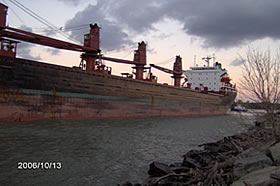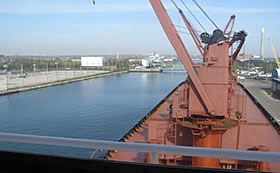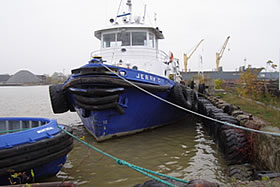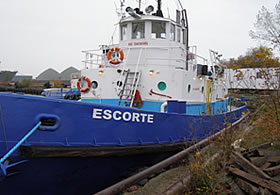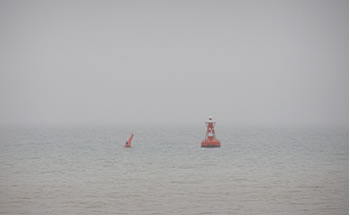Bottom contact and striking
Bulk carrier Seneca
Assisted by tugs Jerry G and Escorte
Oshawa, Ontario
The Transportation Safety Board of Canada (TSB) investigated this occurrence for the purpose of advancing transportation safety. It is not the function of the Board to assign fault or determine civil or criminal liability. This report is not created for use in the context of legal, disciplinary or other proceedings. See Ownership and use of content. Masculine pronouns and position titles may be used to signify all genders to comply with the Canadian Transportation Accident Investigation and Safety Board Act (S.C. 1989, c. 3).
Summary
At 0732 Eastern daylight time on 13 October 2006, the bulk carrier Seneca, with a pilot aboard and assisted by the tugs Jerry G and Escorte, attempted to depart Oshawa Harbour in a strong breeze/near gale, whereupon it ran over two navigation buoys before making bottom contact and striking the eastern seawall at the harbour entrance.
Factual information
Particulars of vessels
| Name | Seneca | Jerry G | Escorte |
|---|---|---|---|
| IMO*/Official Number | 8200486* | 312477 | 817103 |
| Port of registry | Valletta | Montreal | Montreal |
| Flag | Malta | Canada | Canada |
| Type | Geared bulk carrier | Tug | Tug |
| Gross tonnage | 17 822 | 201.99 | 120.05 |
| LengthFootnote 1 | 185 m | 27.95 m | 25.79 m |
| Draught | Forward: 3.93 m Aft: 6.39 m |
Forward: 2.13 m Aft: 3.80 m |
Forward: 1.82 m Aft: 3.35 m |
| Built | 1983, Setoda, Japan | 1960, Lauzon, Canada | 1967, Oyster Bay, U.S.A. |
| Propulsion | Hitachi 7-cylinder B&W diesel, 6833 kW, single screw | EMD diesel 1118 kW, single screw | 2 x Detroit diesel V-12, 1271, 956 kW, Voith-Schneider propulsion systems |
| Cargo | Steel pipes | n/a | n/a |
| Crew | 24 | 2 | 2 |
| Registered owner | Olympic Navigation Co., Marshall Islands | Le Groupe Océan Inc. | Ocean Remorquage Trois-Rivières, Inc. |
| Manager | Amalthia Marine, Inc., Greece | Oceans Ontario Towing, Canada | Oceans Ontario Towing, Canada |
Description of vessels
The geared bulk carrier Seneca (see Photo and Photo 2), formerly the Stokmarnes, Millenium Eagle, and the Mangal Desai, typically delivers steel to Great Lakes ports and leaves with grain for overseas. As with most bulk carriers, when in light loading condition, the vessel presents a significant wind surface area.
The Jerry G (see Photo 3) is a conventional tug with a single-screw, Kort-nozzle, variable-pitch propeller and is assigned mostly to harbour berthings and unberthings.
The tug Escorte (see Photo 4) is a smaller conventional tug. The Escorte is also assigned mostly to ship berthings and unberthings. It is equipped with twin Voith-Schneider propulsion systems. The propellers are located slightly ahead of midships for maximum efficiency. Regardless of the different propulsion systems, both tugs maximize their towing power when using a stern towing arrangement.
History of the voyage
On 12 October 2006, the Seneca discharged approximately 9904 tonnes of steel bundles at the Oshawa marine terminal, leaving 4392 tonnes bound for Toronto, Ontario. The vessel finished unloading and at 2200Footnote 2 was waiting for a pilot. Due to the reduced amount of cargo on board, the Seneca was high out of the water and as a result had a significant wind surface area.
On the morning of October 13 at 0430, a pilot was driven from Hamilton, Ontario, to Oshawa to board the Seneca. At 0555, the pilot boarded the Seneca and proceeded to the bridge to prepare for departure from Oshawa. Following a discussion with the master, it was decided to delay the departure for an hour to await daylight. All the manoeuvring machinery and equipment was tested and found to be working satisfactorily.
At 0645, the master and pilot agreed to a departure plan incorporating two assisting tugs, the Jerry G and Escorte. At this time, winds were as forecasted and estimated to be at 12 to 15 knots from the southwest.
At 0650, the Seneca had a towline connected from the port shoulder to a bow towing securing arrangement of the Jerry G. The Escorte had a towline from the Seneca centre stern connected to its stern towing securing arrangement.
At 0700, winds had increased to 20 to 25 knots. Concerned, the tug master of the Escorte informed the pilot via very high frequency (VHF) radiotelephone of this change. At this time, an Oshawa Harbour port security camera was able to capture images of whitecaps coming off the top of the waves outside of the harbour, in Lake Ontario.
At 0705, the Escorte was reporting wind speeds gusting to 35 knots. The Seneca's master also reported wind speeds above 30 knots, but the pilot indicated that the departure should proceed and the master acquiesced. As of 0707, the bridge team was comprised of the pilot, the master, a wheelsman, and a watchman. The mooring lines were let go at 0707 and the tugs began towing the Seneca away from the terminal dock. After the Seneca was towed approximately 4 to 5 m, it was allowed to drift back to the dock.
The pilot asked the forward tug, the Jerry G, to reconfigure its towline in order to tow from its stern. At 0722, the Seneca was again towed away from the dock.
At 0726, near mid-channel, the tugs were let go, at which time the Seneca had very little forward speed. The investigation was unable to determine who initiated this action.
The Seneca began to move ahead under its own power, heading out of the harbour via the confinedFootnote 3 waters of the channel. The tugs were escorting the Seneca on its starboard side. However, it developed a rapid set to the east under the influence of the wind and, without sufficient speed to maintain course, began to drift towards the channel buoys MV12 and MV10 on its port side. Approaching the harbour entrance, the pilot ordered the engine astern to slow the vessel down to reduce the impact of a potential grounding.
At 0729, buoys MV10 and MV08 disappeared under the Seneca's port quarter and port forward area of the ship's side. The same buoys reappeared a short time later. At approximately the same time while transiting the harbour entrance, the Seneca's port shoulder made bottom contact with the eastern side of the entrance. Simultaneously, the tug Jerry G was ordered to the port bow of Seneca to begin pushing at the port bow in an attempt to prevent the vessel from running aground. The remaining forward motion of the Seneca moved the vessel to a point about midway through the harbour entrance.
At 0732, the wind set the Seneca against the east harbour entrance where it made contact with the eastern seawall just aft of its midship's section. At this time, the tug Escorte reconnected a towline to the Seneca's centre stern and began pulling, while the Jerry G continued to push on the port bow. The stern section swung into a position which blocked the harbour entrance for the next 6 to 7 minutes (see Figure 1).
At 0740, the combined power of the Seneca and the tugs freed the vessel from its position. As the bulk carrier moved forward with the Jerry G pushing on its port bow, buoy MV6 fouled the tug's steering mechanism. This tripped the circuit breakers of the Jerry G's steering system and caused the rudder to briefly fail. The breakers were quickly reset and the tug continued pushing.
As the vessels progressed into the channel, buoy MV6 was dragged approximately 195 m and came to rest near outer buoy MV4. (see Photo 5). Buoy MV6 was significantly damaged.
At 0744, the Seneca cleared the harbour channel. Instead of proceeding to Toronto to unload the remaining cargo, the Seneca proceeded to calling-in point number 15 in Lake Ontario, near Port Weller, Ontario, to await better weather. All the vessel's tanks were sounded and found to be dry with no apparent damage.
Personnel
Bulk carrier Seneca
The master has a Foreign-Going Master's certificate issued in Odessa, Ukraine, in 2003. Since 2005, he has made five trips into the Great Lakes.
The pilot had five years of experience on the Great Lakes, notably in District 1, Lake Ontario. He was given frequent vessel-movement assignments at the ports of Hamilton, Toronto, and Oshawa.
Tug Jerry G
The master of the Jerry G has a Master, Limited Certificate with a continued proficiency endorsement, issued on 30 May 2002. He operated tugs mostly in the lower Great Lakes ports. He has approximately 50 years of experience with tugs; for approximately 35 of those years, he served as a master of fishing vessels and conventional commercial tugs.
Tug Escorte
The master of the Escorte has a Master, Ship of Not More Than 350 ons Gross Tonnage, or Tug Certificate. He has about 20 years of experience as a master of tugs on the Great Lakes and the east coast of Canada.
Communications
The master was comfortable with the limited verbal interaction between the pilot, himself, and the tug masters.
The Seneca, Jerry G, and Escorte communicated on channel 10 VHF radio. Communications were limited to brief messages, typically from the pilot to the tug masters, indicating the towing locations to be used.
Weather
The weather in the Oshawa area was reportedly different than forecasted. The past weather data for Toronto for 13 October 2006 showed a wind direction of southwest at 23 knots.
Damage
The Seneca did not suffer any apparent damage. The Jerry G suffered some minor damage to its steering system electrical components. Spar buoy MV6 was significantly damaged and needed to be replaced.
Findings
Findings as to causes and contributing factors
- Despite the rapidly deteriorating weather conditions, the master and pilot decided to depart Oshawa Harbour.
- The tugs were released before the Seneca had sufficient headway to maintain a proper course through the channel.
- The vessel made bottom contact and struck the eastern seawall entrance at low speed as a result of high winds blowing it out of the channel, insufficient manoeuvring space being available, and attending tugs being ineffectively deployed.
Findings as to risk
- In view of the deteriorating weather and confined channel, the decision by the master and pilot to depart in a light condition put all three vessels and their crews at increased risk.
Safety action
Action taken
Managing company
Based on its own investigation, the company issued a circular to all fleet vessels titled "Office Standing Instructions No. 36 - Instructions on Suspension of Vessel's Movements" that addressed a proper evaluation by the master of the prevailing weather conditions prior to any vessel's movement in a port and the master's overriding authority to postpone or suspend intended operations, regardless of pilot advice.
This report concludes the Transportation Safety Board's investigation into this occurrence. Consequently, the Board authorized the release of this report on .
